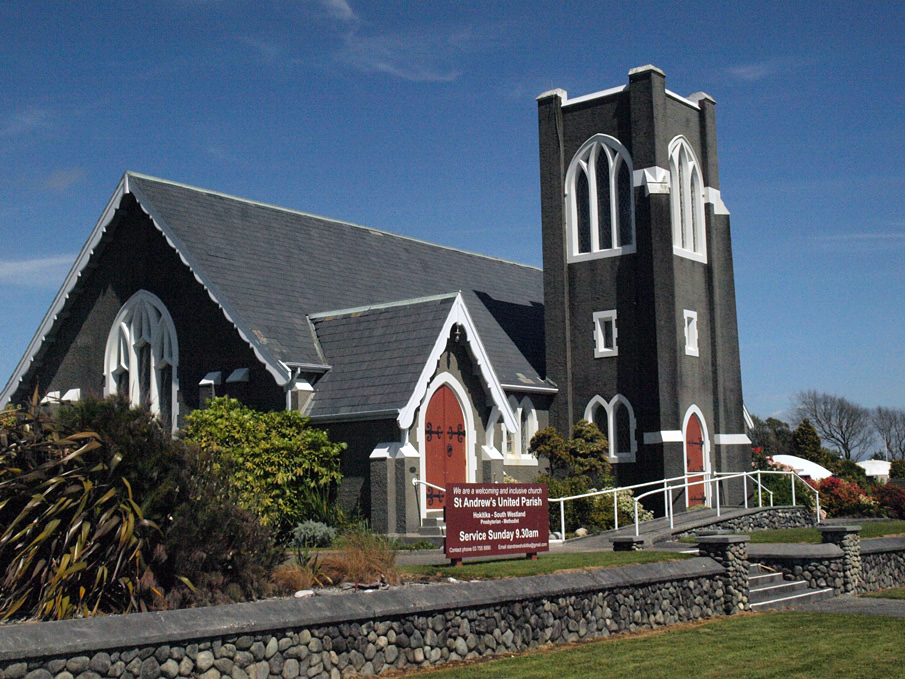The grey and white church of St Andrew's at Hokitika was erected in 1935 as a memorial to the Presbyterian and Scottish residents of the area who died during the First World War, and as a replacement for the 1867 church. The town of Hokitika was established after gold was found in the area in 1864. As well as the hotels, shops and governmental agencies set up to service the miners, a number of religious organisations also settled in the town. When the town was surveyed in 1865 the government provided sections for various religious denominations. By 1866 a Masonic Hall, Jewish synagogue, Wesleyan church and a Roman Catholic church had been built and an Anglican church was near completion. Presbyterian services were first held in the courthouse at Hokitika and then in the Fire Brigade Hall. The first Presbyterian church to be built in Hokitika was wooden, erected on a section originally set aside for a Congregational church. Opened early in 1867, this church survived until 1946 but was used for the last ten years of its life as a Sunday school only. Shortly after the signing of the Armistice in 1918 the Presbyterian congregation of Hokitika decided to erect a new church, which would serve as a memorial to the local Presbyterians and Scots who had fought and died in World War I. The first sod was turned at a ceremony on 19 July 1919 but difficulties with both funding and the site meant that construction on St Andrew's did not start until 1935 and, when it did, it was on a different section of land. St Andrew's was designed by Christchurch architect Roy Lovell-Smith (1884-1972), one of a number of churches he designed throughout his career. It appears that Lovell-Smith was commissioned to design the church around 1931, the date of his first drawings. The construction of St Andrew's is relatively unusual, as Lovell-Smith designed it to be built from reinforced concrete with a timber ceiling and slate roof. The exterior walls mostly consist of two panels of four-inch reinforced concrete separated by a six-inch cavity and was constructed this way to 'resist earthquakes and exclude moisture'. Interestingly, although Lovell-Smith's first drawings show solid concrete walls, by 1935 his plans had evolved to include a cavity. St Andrew's is Gothic in style, with a square tower, lancet windows and an apsidal end, which, unusually, contains the choir vestry. Inside the floor plan is non-conformist in layout and the furniture and fittings are rimu. These include the pulpit, choir rail, communion table, and the Minister's and Elders' chairs, all designed by Lovell-Smith. The end of the kneeling rails are decorated with a carved thistle while a representation of the St Andrew's cross decorates the chairs. The woodwork of the pulpit, communion table and choir screen mirrors the arches of the east window. At the time it opened the interior walls were plastered in white, and blue carpets covered the floors. The Roll of Honour, carved in marble, is mounted just inside the entrance. As with other Presbyterian churches throughout New Zealand, St Andrew's united with the local Methodist church in 1970, and is now known as St Andrew's United Church. St Andrew's was the first Presbyterian congregation to be established on West Coast. The church building itself is a significant example of Lovell-Smith's ecclesiastical work and one of only a handful of churches throughout New Zealand constructed in reinforced concrete prior to World War II. It is one of only a few churches to be specifically built as a war memorial. St Andrews is a distinctive feature of Hokitika and is still used for worship today.



Location
List Entry Information
Overview
Detailed List Entry
Status
Listed
List Entry Status
Historic Place Category 1
Access
Private/No Public Access
List Number
5013
Date Entered
6th June 1990
Date of Effect
6th June 1990
City/District Council
Westland District
Region
West Coast Region
Extent of List Entry
Extent includes the land described as Sec 1129 TN of Hokitika (RT WS3A/268), Westland Land District and the building known as St Andrew's United Church (Presbyterian/Methodist) thereon. Refer to the extent map tabled at the Heritage New Zealand Board meeting on 3 September 2015.
Legal description
Sec 1129 TN of Hokitika (RT WS3A/268), Westland Land District
Stay up to date with Heritage this month
